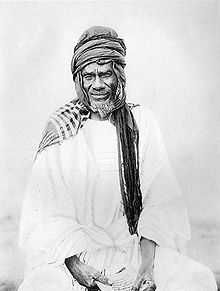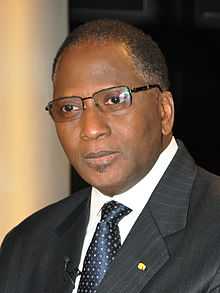Mandinka people
|
Some West Africans from the Mandinka ethnic group: Samory Touré · Sekou Touré · Lansana Kouyaté Salif Keita · Modibo Sidibé · Toumani Diabaté · Yaya Touré · Mohamed Sissoko | |
| Total population | |
|---|---|
| 13 million | |
| Regions with significant populations | |
| 714,000 (42%)[1] | |
| 3,063,431 (30%)[2] | |
| 2,638 988 (22%) | |
| 5,123,420 (21%)[3] | |
| 1,984,200 (15%) | |
| 208,180 (13%)[4] | |
| 306 900 (10%) | |
| 465,813 (8%) | |
| 245,300 (7.4%) | |
| 687,822 (7%)[5] | |
| Languages | |
|
Mandinka language Eastern Maninka Western Maninka Kita Maninka | |
| Related ethnic groups | |
| Mandé peoples, especially the Dyula, Khassonké and Bambara | |
The Mandinka, Malinke (also known as Mandinko or Mandingo) is a West African ethnic group with an estimated global population of eleven million (the other three major ethnic groups in the region being the non-related Fula, Hausa and Songhai). They belong to the larger Mandé group of peoples.
They are the descendants of the Mali Empire, which rose to power under the rule of the Mandinka king Sundiata Keita. The Mandinka in turn belong to West Africa's largest ethnolinguistic group, the Mandé, who account for more than twenty million people (including the Dyula, Bozo, Bissa and Bambara). Today, over 99% of Mandinka in Africa are Muslim.[6][7]
The Mandinka live primarily in West Africa, particularly in the Gambia, Guinea, Mali, Sierra Leone, Côte d'Ivoire, Senegal, Burkina Faso, Liberia, Guinea-Bissau, Niger and Mauritania. Although widespread, the Mandinka do not form the largest ethnic group in any of the countries in which they live except the Gambia. Most Mandinkas live in family-related compounds in traditional rural villages. Mandinka villages are fairly autonomous and self-ruled, being led by a chief and group of elders. Mandinkas live in an oral society. Learning is traditionally done through stories, songs and proverbs.
Originally from Mali, the Mandinka gained their independence from previous empires in the thirteenth century, and founded an empire which stretched across West Africa. They migrated west from the Niger River in search of better agricultural lands and more opportunities for conquest. Through a series of conflicts, the Fula jihads, primarily with the Fula-led Imamate of Futa Jallon, around half of the Mandinka population converted from indigenous beliefs to Islam. During the 16th, 17th, and 18th century, many Mandinka were enslaved and shipped to the Americas through capture in conflict and therefore a significant portion of the African Americans in the United States are descended from the Mandinka people.[8]
History
The Mandinka migrated west from the Niger River basin in search of better agricultural, land, and more opportunities for conquest. The Mandés founded the empire of Kaabu, comprising twenty small kingdoms. Some upper-class or urban Mandinkas converted to Islam during the reign of the Mansa Musa (1312–1337 AD).
The majority of the Mandinka were still animists at the beginning of the 18th century. Through a series of conflicts, primarily with the Fula-led Imamate of Futa Jallon and amongst sub-states of the Kaabu, about half of the Senegambian Mandinka were converted to Islam while as many as a third were sold into slavery to the Americas through capture in conflict.) Today, the majority of Mandinka are Muslim. A significant portion of African-Americans in North America are descended from Mandinka people.[8]


In eastern areas (northern Côte d'Ivoire, Burkina Faso and Southern Mali), Mandinka communities are often built around long distance trade routes. These people, often called Dyula after the Mandé word for "merchant", built communities in trading centers, spaced along trade routes, and near mining and agricultural centers, beginning during the Mali Empire.
These merchant networks formed the lynchpin of trade between the desert-side upper Niger River cities (Djenné and Timbuktu, for example), highland production areas (the goldfields of Bambouk or agricultural centre of Kankan), and the coast. This last link became more important with the advent of Portuguese and other European trading posts in the 17th century, and much of the overland trade connecting the coast and interior (including the African slave trade) was controlled by Dyula merchants.
Economy
Mandinka are rural subsistence farmers in the Sahel who rely on peanuts, rice, millet, maize and small-scale husbandry for their livelihood. During the wet season, men plant peanuts as their main cash crop. Men also grow millet and Women work in the rice fields, tending the plants by hand. [9] This is extremely labour-intensive and physically demanding work. Only about 50% of the rice consumption needs are met by local planting; the rest is imported from Asia and the United States. [10]
The oldest male is the head of the family and marriages are commonly arranged. Small mud houses with conical thatch or tin roofs make up their villages, which are organized on the basis of the clan groups. While farming is the predominant profession among the Mandinka, men also work as tailors, butchers, taxi drivers, woodworkers, metalworkers, soldiers, nurses, and extension workers for aid agencies. However, most women, probably 95%, tend to the home, children, and animals as well as work alongside the men in the fields.
Culture
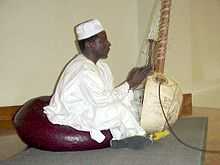
Mandinka culture is rich in tradition, music, and spiritual ritual. Mandinkas continue a long oral history tradition through stories, songs and proverbs. In rural areas, western education's impact is minimal; the literacy rate in Latin script among these Mandinka is quite low. However, more than half the adult population can read the local Arabic script (including Mandinka Ajami); small Qur'anic schools for children where this is taught are quite more common. Mandinka children are given their name on the eighth day after their birth, and their children are almost always named after a very important person in their family.
The Mandinka have a rich oral history that is passed down through griots. This passing down of oral history through music has made music one of the most distinctive traits of the Mandinka. They have long been known for their drumming and also for their unique musical instrument, the kora. The kora is a twenty-one-stringed guitar-like instrument made out of a halved, dried, hollowed-out gourd covered with cow or goat skin. The strings are made of fishing line (these were traditionally made from cow's tendons). It is played to accompany a griot's singing or simply on its own.
A Mandinka religious and cultural site under consideration for World Heritage status is located in Guinea at Gberedou/Hamana.[11]
Customs

Most Mandinkas live in family-related compounds in traditional rural villages. Mandinka villages are fairly autonomous and self-ruled, being led by a council of upper class elders and a chief who functions as a first among equals.
Passage into adulthood
The Mandinka practice a rite of passage, Kankurang, which marks the beginning of adulthood for their children. At an age between four and fourteen, the youngsters have their genitalia ritually cut (see articles on male and female genital cutting), in separate groups according to their sex. In years past, the children spent up to a year in the bush, but that has been reduced now to coincide with their physical healing time, between three and four weeks.
During this time, they learn about their adult social responsibilities and rules of behavior.
Preparation is made in the village or compound for the return of the children. A celebration marks the return of these new adults to their families.
As a result of these traditional teachings, in marriage a woman's loyalty remains to her parents and her family; a man's to his.
Marriage
Marriages are traditionally arranged by family members rather than either the bride or groom. This practice is particularly prevalent in the rural areas. Kola nuts, a bitter nut from a tree, are formally sent by the suitor's family to the male elders of the bride-to-be, and if accepted, the courtship begins.
Polygamy has been practiced among the Mandinka since pre-Islamic days. A Mandinka man is legally allowed to have up to four wives, as long as he is able to care for each of them equally. Mandinka believe the crowning glory of any woman is the ability to produce children, especially sons. The first wife has authority over any subsequent wives. The husband has complete control over his wives and is responsible for feeding and clothing them. He also helps the wives' parents when necessary. Wives are expected to live together in harmony, at least superficially. They share work responsibilities of the compound, such as cooking, laundry, and other tasks.
Religion
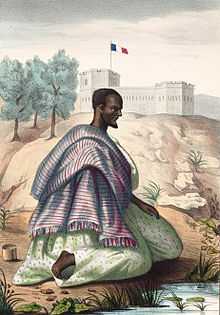
Today, over 99% of Mandinka are Muslim.[6][7] Mandinkas will recite chapters of the Qur'an in Arabic. Some Mandinka syncretize Islam and traditional African religions. Among the Mandinka spirits can be controlled mainly through the power of a marabout, who knows the protective formulas. In most cases, no important decision is made without first consulting a marabout. Marabouts, who have Islamic training, write Qur'anic verses on slips of paper and sew them into leather pouches (talisman); these are worn as protective amulets.
The kora
The kora has become the hallmark of traditional Mandinka musicians". The kora with its 21 strings is made from half a calabash, covered with cow's hide fastened on by decorative tacks. The kora has sound holes in the side which are used to store coins offered to the praise singers, in appreciation of their performance. The praise singers are called "jalibaa" in Mandinka. According to The Kora (2002): as [the kora] is played, it begins to take on a life of its own and it is believed that the singer and the instrument become one".
The kora was traditionally used as "storage for historical facts, to memorize the genealogy of patron families and sing their praises, to act as messengers and intermediaries in disputes between families, to serve as guardians of traditional culture, and to entertain". Today, however, the kora is losing its importance. Although it is a skill passed down from father to son, it is primarily used to entertain people, most especially tourists.
In literature and other media
One Mandinka outside Africa is Kunta Kinte, a main figure in Alex Haley's book Roots and a subsequent TV mini-series. Haley claimed he was descended from Kinte, though this familial link has been criticized by many professional historians and at least one genealogist as highly improbable (see D. Wright's The World And A Very Small Place). Martin R. Delany, a 19th-century abolitionist, military leader, politician and physician in the United States, was of partial Mandinka descent.
Sinéad O'Connor's 1988 hit Mandinka was inspired by Alex Haley's book.
Mr. T, of American television fame, once claimed that his distinctive hairstyle was modeled after a Mandinka warrior that he saw in National Geographic magazine.[12] In his motivational video Be Somebody... or Be Somebody's Fool!, he states that "My folks came from Africa. They were from the Mandinka tribe. They wore their hair like this. These gold chains I wear symbolize the fact that my ancestors were brought over here as slaves."[13] In a 2006 interview, he reiterated that he modeled his hair style after photographs of Mandinka men he saw in National Geographic.[14]
Many early works by Malian author Massa Makan Diabaté are retellings of Mandinka legends, including Janjon, which won the 1971 Grand prix littéraire d'Afrique noire. His novels The Lieutenant of Kouta, The Barber of Kouta, and The Butcher of Kouta attempt to capture the proverbs and customs of the Mandinka people in novelistic form.
Notable people by country
Sierra Leone
- Alhaji Ahmad Tejan Kabbah, President of Sierra Leone from 1996–2007
- Haja Afsatu Kabba, Former Sierra Leone's Minister of Marine Resources and Fisheries; Energy and Power; Lands
- Alhaji Mohamed Kemoh Fadika, current Sierra Leone's High Commissioner to The Gambia and former High Commissioner to Nigeria, former Ambassador to Egypt and Iran.
- Mabinty Daramy, current Sierra Leone's Deputy Minister of Trade and Industry
- Fode Dabo, former Sierra Leone Ambassador to Belgium, France, Netherlands, Luxemburg and Italy and former High Commissioner to The Gambia.
- Alhaji Shekuba Saccoh, former Sierra Leone's ambassador to Guinea and former Minister of Social Welfare
- Ibrahim Jaffa Condeh, Sierra Leonean journalist and news anchor
- Neneh Dabo, former Director of the Sierra Leone Anti Corruption Commission (ACC).
- Mohamed Kakay, former MP of Sierra Leone from Koinadugu District (SLPP)
- Mohamed B. Daramy, former minister of Development and Economic Planning from 2002–2007, former ECOWAS Commissioner of Income Tax.
- Alhaji A. B. Sheriff, former MP from Koinadugu District (SLPP)
- Tejan Amadu Mansaray, former MP of Sierra Leone representing Koinadugu District (APC)
- Kadijatu Kebbay, Sierra Leonean model; Miss University Sierra Leone 2006 winner and represent Sierra Leone at the Miss World 2006 contest.
- Sheka Tarawalie, Sierra Leonean journalist and former State House Press Secretary to president Koroma. Former Deputy Minister of Information and current Deputy Minister of Internal Affairs.
- Alhaji Bomba Jawara, former MP of Sierra Leone from Koinadugu District (SLPP)
- Kanji Daramy, Sierra Leonean journalist and spokesman for former Sierra Leone's president Ahmad Tejan Kabbah. He is also the former Chairman of Sierra Leone National Telecommunications Commission
- Brima Dawson Kuyateh, Sierra Leonean journalist and the current president of the Sierra Leone Reporters Union
- Karamoh Kabba, Sierra Leonean author, writer and journalist
- Sitta Umaru Turay, Sierra Leonean journalist
- K-Man (born Mohamed Saccoh), Sierra Leonean musician
- Alhaji Lansana Fadika, Sierra Leonean businessman and former SLPP chairman for the Western Area. He is the younger brother of Kemoh Fadika.
- Sidique Mansaray, Sierra Leonean footballer
- Isha Sesay, journalist
- Lansana Baryoh, Sierra Leonean footballer
- Brima Keita, Sierra Leonean football manager
Guinea

- Samory Touré, founder of the Wassoulou Empire, an Islamic military state that resisted French rule in West Africa
- Sekou Touré, President of Guinea from 1958–1984; was also the grandson of Samory Touré
- Alpha Condé, current Guinean President
- Lansana Kouyaté, former prime minister of Guinea
- Kabiné Komara, current Prime Minister of Guinea
- Sekouba Bambino, Guinean musician
- Sona Tata Condé, Guinean musician
- Fodé Mansaré, Guinean footballer
- Daouda Jabi, Guinean footballer
- Mamadi Kaba, Guinean footballer
- N'Faly Kouyate, Guinean musician
- Kaba Diawara, Guinean footballer
- Mamady Keïta, Guinean musician
- Mory Kanté, Guinean kora musician
- Mamady Condé, Guinean foreign minister from 2004–2007
- Alhassane Keita, Guinean footballer
- Djeli Moussa Diawara, Guinean musician (also known as Jali Musa Jawara - 32-stringed Kora player)
- Famoudou Konaté, Guinean musician
Liberia
- Momolu Dukuly, former Liberian foreign minister
Gambia
- Alhajj Sir Dawda Kairaba Jawara, first President of the Gambia
- Sheriff Mustapha Dibba, Veteran politician and the First vice President of the Gambia
- Ousainou Darboe, Gambian opposition leader
- Sidia Jatta, opposition politician
- Jatto Ceesay, footballer
- Foday Musa Suso, international musician.
- Kunta Kinte, one of the most famous first-generation African slaves.
Mali

- Mansa Musa, the most famous and celebrated of all the Malian emperors
- Sundiata Keita, founder of the Mali Empire
- Modibo Sidibé, current Prime Minister of Mali
- Modibo Keïta, President of Mali from 1960–1968
- Yoro Diakité, former Malian Prime Minister
- Salif Keita, Malian musician
- Daba Diawara, Malian politician
- Toumani Diabaté, Malian musician
- Massa Makan Diabaté, Malian historian, writer and playwright
- Moussa Kouyate, Malian musician
- Saidu Keita, Malian footballer
- Baba Sissoko, Malian musician
- Aoua Kéita, Malian politician and activist
- Mamady Sidibé, Malian footballer
- Mohamed Sissoko, Malian footballer
- Soumaila Coulibaly, Malian footballer
- Amadou Toumani Touré,Ex President of Mali
- Mamadou Diabate Malian musician
Côte d'Ivoire
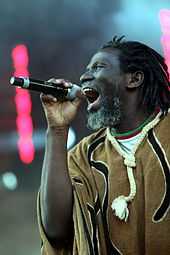
- Alassane Ouattara, current President of Côte d'Ivoire
- Sékou Touré (Côte d’Ivoire) Ivorian politician, Environmental Engineer, former UN Executive
- Tiken Jah Fakoly, Ivorian (Reggae) musician
- Guillaume Soro, Ivorian politician
- Henriette Diabaté, Ivorian politician, former
- Kolo Touré, Ivorian footballer
- Arouna Koné, Ivorian footballer
- Abdul Kader Keïta, Ivorian footballer
- Bakari Koné, Ivorian footballer
- Alpha Blondy, Ivorian (Reggae) musician
- Yaya Touré, Ivorian footballer
- Ahmadou Kourouma, Ivoirian writer.
Senegal
- Seckou Keita, Senegalese musician
- Souleymane Diawara, Senegalese footballer
- Papiss Demba Cisse,Senegalese footballer
Burkina Faso
- Amadou Coulibaly, Burkinabé footballer
- Cheick Kongo, Burkinabé mixed martial artist
- Joseph Ki-Zerbo, political leader and historian
United States of America
- Martin Delany, abolitionist, journalist, physician, and writer
- Alex Haley, writer and author of the 1976 book Roots: The Saga of an American Family
- Foday Musa Suso, griot musician and composer
- Black Thought, rapper and co-founder of hip hop band The Roots
See also
References
- ↑ pt. "Mandinka Tribe, Gambia". Accessgambia.com. Retrieved 2013-10-12.
- ↑ "Ethnic groups - Guinea". Nationsencyclopedia.com. Retrieved 2013-10-12.
- ↑ "Ivory Coast - Ethnic Groups And Languages". Countrystudies.us. Retrieved 2013-10-12.
- ↑ "Ethnic groups - Guinea-Bissau". Nationsencyclopedia.com. Retrieved 2013-10-12.
- ↑ Joshua Project (2009-02-04). "Mandingo, Mandinka of Senegal Ethnic People Profile". Joshuaproject.net. Retrieved 2013-10-12.
- ↑ 6.0 6.1 Logon, Roberta A. (May 2007). "Sundiata of mali". Calliope 17 (9): 34–38.
- ↑ 7.0 7.1 Quinn, Charlotte A.; Quinn, Charlotte A. (Dec 1973). "Mandingo Kingdoms of the Senegambia: Traditionalism, Islam and European Expansion". The American Historical Review 78 (5): 1506–1507. doi:10.2307/1854194. JSTOR 1854194.
- ↑ 8.0 8.1 "Bound To Africa — The Mandinka Legacy In The New World" (PDF). Retrieved 2013-10-12.
- ↑ Schaffer, Matt (2003). Djinns, Stars, and Warriors: Mandinka Legends from Pakao, Senegal. Leiden: Springer-Brill. p. 6.
- ↑ Schaffer, Matt (2003). Djinns, Stars, and Warriors: Mandinka Legends from Pakao, Senegal. Leiden: Springer-Brill. p. 6.
- ↑ "Architecture vernaculaire et paysage culturel mandingue du Gberedou/Hamana - UNESCO World Heritage Centre". whc.unesco.org. Retrieved 2009-04-12.
- ↑ Mentioned in a number of interviews, including Mr. T: Pity The Fool, allhiphop.com, Published Thursday, November 09, 2006. Mr. T gives a 1977 date, for an article with photos on the Mandinka in Mali. National Geographic Magazine's index has no record of such an article. http://publicationsindex.nationalgeographic.com/.
- ↑
- ↑ Mr. T: Pity The Fool interview by Greg Watkins
Further reading
- Charry, Eric S. (2000). Mande Music: Traditional and Modern Music of the Maninka and Mandinka of Western Africa. Chicago: University of Chicago Press. ISBN 0-226-10161-4.
- Robert W. Nicholls. "The Mocko Jumbie of the U.S. Virgin Islands; History and Antecedents". African Arts, Vol. 32, No. 3 (Autumn, 1999), pp. 48–61+94-96
- Matt Schaffer (Editor). "Djinns, Stars and Warriors: Mandinka Legends from Pakao, Senegal" (African Sources for African History, 5) Brill Academic Publishers (2003) ISBN 978-90-04-13124-8
- Matt Schaffer. "Bound to Africa: The Mandinka Legacy in The New World". History in Africa 32 (2005) 321-369
- Robert J. Mundt. Historical Dictionary of the Ivory Coast (Côte d'Ivoire). Scarecrow Press/ Metuchen. NJ - Kondon (1987) pp. 98–99
- Lucie Gallistel Colvin. Historical Dictionary of Senegal. Scarecrow Press/ Metuchen. NJ - Kondon (1981) pp. 216–217
- Pascal James Imperato. Historical Dictionary of Mali. Scarecrow Press/ Metuchen. NJ - Kondon (1986) pp. 190–191
- ETHNOLOGUE Languages of the World- Thirteenth Edition (1996).
External links
- Mandinka
- Malinke
- A UK based website devoted to playing Malinke djembe rhythms
- The Ethnologue page for this people group
 Texts on Wikisource:
Texts on Wikisource:
- "Mandingo". New International Encyclopedia. 1905.
- "Mandingo". Encyclopædia Britannica (11th ed.). 1911.
| ||||||||||||||||||||||||||||||||||||||||||
